Microstructured Waveguides with Polyelectrolyte-Stabilized Gold Nanostars for SERS Sensing of Dissolved Analytes
Abstract
:1. Introduction
2. Materials and Methods
3. Results and Discussion
4. Conclusions
Author Contributions
Funding
Conflicts of Interest
References
- Atkin, D.M.; Shepherd, T.J.; Birks, T.A.; Russell, P.S.J.; Roberts, P.J. Full 2-D photonic bandgaps in silica/air structures. Electron. Lett. 1995, 31, 1941–1943. [Google Scholar] [CrossRef]
- Knight, J.C. Photonic Band Gap Guidance in Optical Fibers. Science 1998, 282, 1476–1478. [Google Scholar] [CrossRef] [PubMed]
- Russell, P.S.J. Photonic Crystal Fibers. Science 2003, 299, 358–362. [Google Scholar] [CrossRef] [PubMed]
- Knight, J.C. Photonic crystal fibres. Nature 2003, 424, 847–851. [Google Scholar] [CrossRef] [PubMed]
- Russell, P.S.J. Photonic-Crystal Fibers. J. Light. Technol. 2006, 24, 4729–4749. [Google Scholar] [CrossRef]
- Pidenko, S.A.; Burmistrova, N.A.; Shuvalov, A.A.; Chibrova, A.A.; Skibina, Y.S.; Goryacheva, I.Y. Microstructured optical fiber-based luminescent biosensing: Is there any light at the end of the tunnel?—A review. Anal. Chim. Acta 2017. [Google Scholar] [CrossRef] [PubMed]
- Dudley, J.M.; Genty, G.; Coen, S. Supercontinuum generation in photonic crystal fiber. Rev. Mod. Phys. 2006, 78, 1135–1184. [Google Scholar] [CrossRef]
- Cialla-May, D.; Zheng, X.-S.; Weber, K.; Popp, J. Recent progress in surface-enhanced Raman spectroscopy for biological and biomedical applications: from cells to clinics. Chem. Thereforec. Rev. 2017, 46, 3945–3961. [Google Scholar] [CrossRef] [PubMed]
- Gottschall, T.; Meyer, T.; Schmitt, M.; Popp, J.; Limpert, J.; Tünnermann, A. Advances in laser concepts for multiplex, coherent Raman scattering micro-spectroscopy and imaging. TrAC Trends Anal. Chem. 2018, 102, 103–109. [Google Scholar] [CrossRef]
- Yan, D.; Popp, J.; Frosch, T. Analysis of Fiber-Enhanced Raman Gas Sensing Based on Raman Chemical Imaging. Anal. Chem. 2017, 89, 12269–12275. [Google Scholar] [CrossRef] [PubMed]
- Kahl, M.; Voges, E.; Kostrewa, S.; Viets, C.; Hill, W. Periodically structured metallic substrates for SERS. Sensors Actuators B Chem. 1998, 51, 285–291. [Google Scholar] [CrossRef]
- Tripp, R.A.; Dluhy, R.A.; Zhao, Y. Novel nanostructures for SERS biosensing. Nano Today 2008, 3, 31–37. [Google Scholar] [CrossRef]
- Khlebtsov, B.N.; Khanadeev, V.A.; Panfilova, E.V.; Bratashov, D.N.; Khlebtsov, N.G. Gold Nanoisland Films as Reproducible SERS Substrates for Highly Sensitive Detection of Fungicides. ACS Appl. Mater. Interfaces 2015, 7, 6518–6529. [Google Scholar] [CrossRef] [PubMed]
- Lim, D.-K.; Jeon, K.-S.; Hwang, J.-H.; Kim, H.; Kwon, S.; Suh, Y.D.; Nam, J.-M. Highly uniform and reproducible surface-enhanced Raman scattering from DNA-tailorable nanoparticles with 1-nm interior gap. Nat. Nanotechnol. 2011, 6, 452–460. [Google Scholar] [CrossRef] [PubMed]
- Frosch, T.; Yan, D.; Hanf, S.; Popp, J. Fiber enhanced Raman spectroscopy. In Proc. SPIE 9157, 23rd International Conference on Optical Fibre Sensors; SPIE: Bellingham, WA, USA, 2014; pp. 9157–9157-4. [Google Scholar]
- White, D.J.; Stoddart, P.R. Nanostructured optical fiber with surface-enhanced Raman scattering functionality. Opt. Lett. 2005, 30, 598. [Google Scholar] [CrossRef] [PubMed]
- Yang, X.; Shi, C.; Newhouse, R.; Zhang, J.Z.; Gu, C. Hollow-Core Photonic Crystal Fibers for Surface-Enhanced Raman Scattering Probes. Int. J. Opt. 2011, 2011, 1–11. [Google Scholar] [CrossRef]
- Yan, D.; Popp, J.; Pletz, M.W.; Frosch, T. Highly Sensitive Broadband Raman Sensing of Antibiotics in Step-Index Hollow-Core Photonic Crystal Fibers. ACS Photonics 2017, 4, 138–145. [Google Scholar] [CrossRef]
- Yan, D.; Popp, J.; Pletz, M.W.; Frosch, T. Fiber enhanced Raman sensing of levofloxacin by PCF bandgap-shifting into the visible range. Anal. Methods 2018, 10, 586–592. [Google Scholar] [CrossRef]
- Zhang, N.; Humbert, G.; Gong, T.; Shum, P.P.; Li, K.; Auguste, J.-L.; Wu, Z.; Hu, D.J.J.; Luan, F.; Dinh, Q.X.; Olivo, M.; Wei, L. Side-channel photonic crystal fiber for surface enhanced Raman scattering sensing. Sensors Actuators B Chem. 2016, 223, 195–201. [Google Scholar] [CrossRef]
- Shi, C.; Lu, C.; Gu, C.; Tian, L.; Newhouse, R.; Chen, S.; Zhang, J.Z. Inner wall coated hollow core waveguide sensor based on double substrate surface enhanced Raman scattering. Appl. Phys. Lett. 2008, 93, 153101. [Google Scholar] [CrossRef]
- Yan, H.; Gu, C.; Yang, C.; Liu, J.; Jin, G.; Zhang, J.; Hou, L.; Yao, Y. Hollow core photonic crystal fiber surface-enhanced Raman probe. Appl. Phys. Lett. 2006, 89, 204101. [Google Scholar] [CrossRef]
- Amezcua-Correa, A.; Yang, J.; Finlayson, C.E.; Peacock, A.C.; Hayes, J.R.; Sazio, P.J.A.; Baumberg, J.J.; Howdle, S.M. Surface-Enhanced Raman Scattering Using Microstructured Optical Fiber Substrates. Adv. Funct. Mater. 2007, 17, 2024–2030. [Google Scholar] [CrossRef]
- Yan, D.; Domes, C.; Domes, R.; Frosch, T.; Popp, J.; Pletz, M.W.; Frosch, T. Fiber enhanced Raman spectroscopic analysis as a novel method for diagnosis and monitoring of diseases related to hyperbilirubinemia and hyperbiliverdinemia. Analyst 2016, 141, 6104–6115. [Google Scholar] [CrossRef] [PubMed]
- Pidenko, P.S.; Borzov, V.M.; Savenko, O.A.; Skaptsov, A.A.; Skibina, Y.S.; Goryacheva, I.Y.; Rusanova, T.Y. Мodification of the internal surface of photonic crystal fibers with Ag and Au nanoparticles for application as sensor elements. In Saratov Fall Meeting 2016: Optical Technologies in Biophysics and Medicine XVIII; SPIE: Bellingham, WA, USA, 2017; Volume 101336, p. 103360T. [Google Scholar]
- Huang, J.; Shi, T.; Tang, Z.; Zhu, W.; Liao, G.; Li, X.; Gong, B.; Zhou, T. Extracting Optical Fiber Background from Surface-Enhanced Raman Spectroscopy Spectra Based on Bi-Objective Optimization Modeling. Appl. Spectrosc. 2017, 71, 1808–1815. [Google Scholar] [CrossRef] [PubMed]
- Zharkova, I.S.; Zhangazieva, G.G.; Skibina, Y.S.; Goryacheva, I.Y. Control of Adsorption Horseradish Peroxidase on the Surface of Glass Multicapillary by Using a Polyelectrolyte on Layer-by-Layer Technology. Nanotechnologies Russ. 2017, 12, 480–484. [Google Scholar] [CrossRef]
- Markin, A.V.; Markina, N.E.; Goryacheva, I.Y. Raman spectroscopy based analysis inside photonic-crystal fibers. TrAC Trends Anal. Chem. 2017, 88, 185–197. [Google Scholar] [CrossRef]
- Beloglazov, V.I.; Chainikov, M.V.; Skibina, Y.S.; Tuchin, V.V. Spectral properties of a soft glass photonic crystal fiber. J. Xray. Sci. Technol. 2005, 13, 171–177. [Google Scholar]
- Khlebtsov, B.; Panfilova, E.; Khanadeev, V.; Khlebtsov, N. Improved size-tunable synthesis and SERS properties of Au nanostars. J. Nanoparticle Res. 2014, 16, 2623. [Google Scholar] [CrossRef]
- Malynych, S.; Luzinov, I.; Chumanov, G. Poly(Vinyl Pyridine) as a Universal Surface Modifier for Immobilization of Nanoparticles. J. Phys. Chem. B 2002, 106, 1280–1285. [Google Scholar] [CrossRef]
- Korolovych, V.F.; Grishina, O.A.; Inozemtseva, O.A.; Selifonov, A.V.; Bratashov, D.N.; Suchkov, S.G.; Bulavin, L.A.; Glukhova, O.E.; Sukhorukov, G.B.; Gorin, D.A. Impact of high-frequency ultrasound on nanocomposite microcapsules: in silico and in situ visualization. Phys. Chem. Chem. Phys. 2016, 18, 2389–2397. [Google Scholar] [CrossRef] [PubMed]
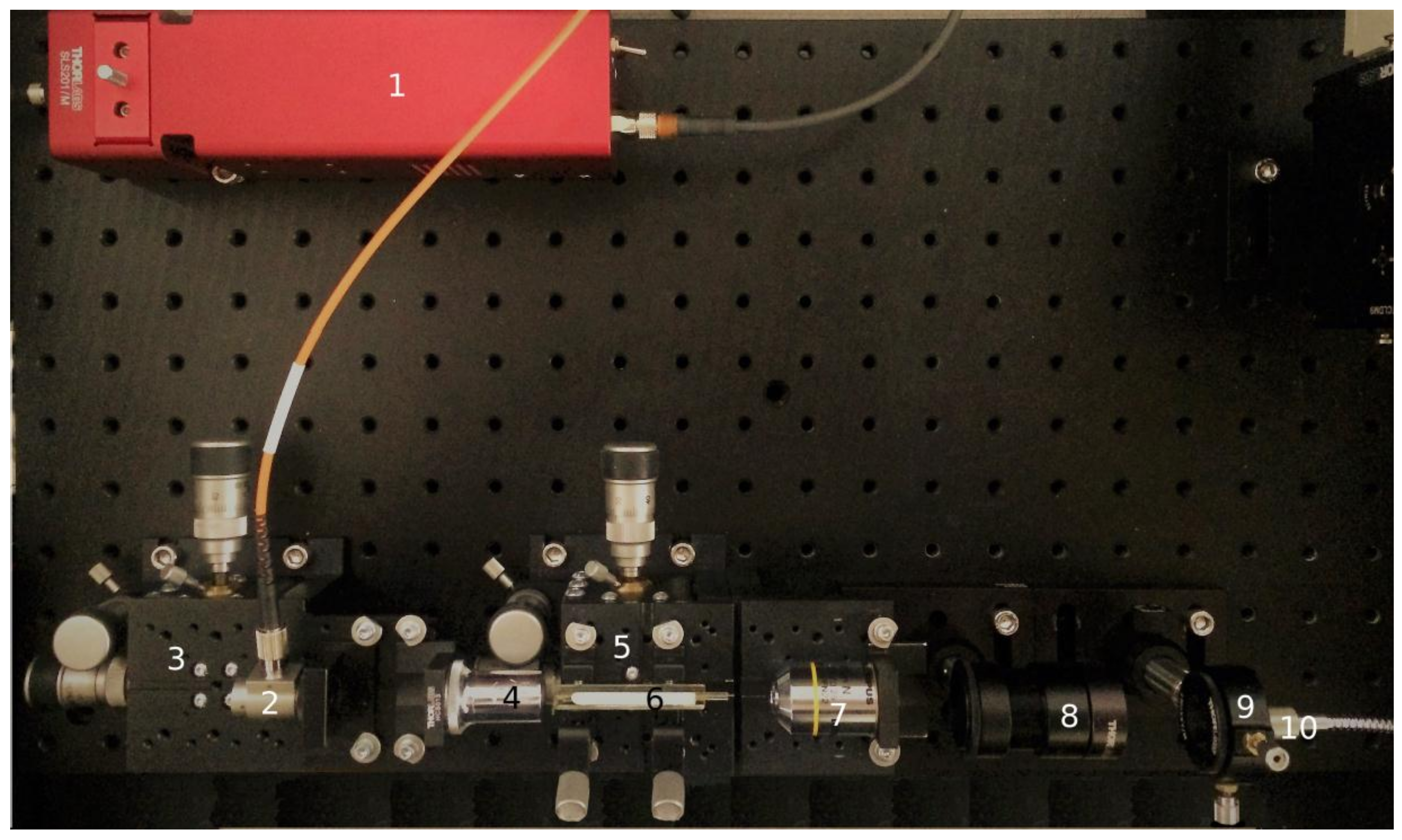
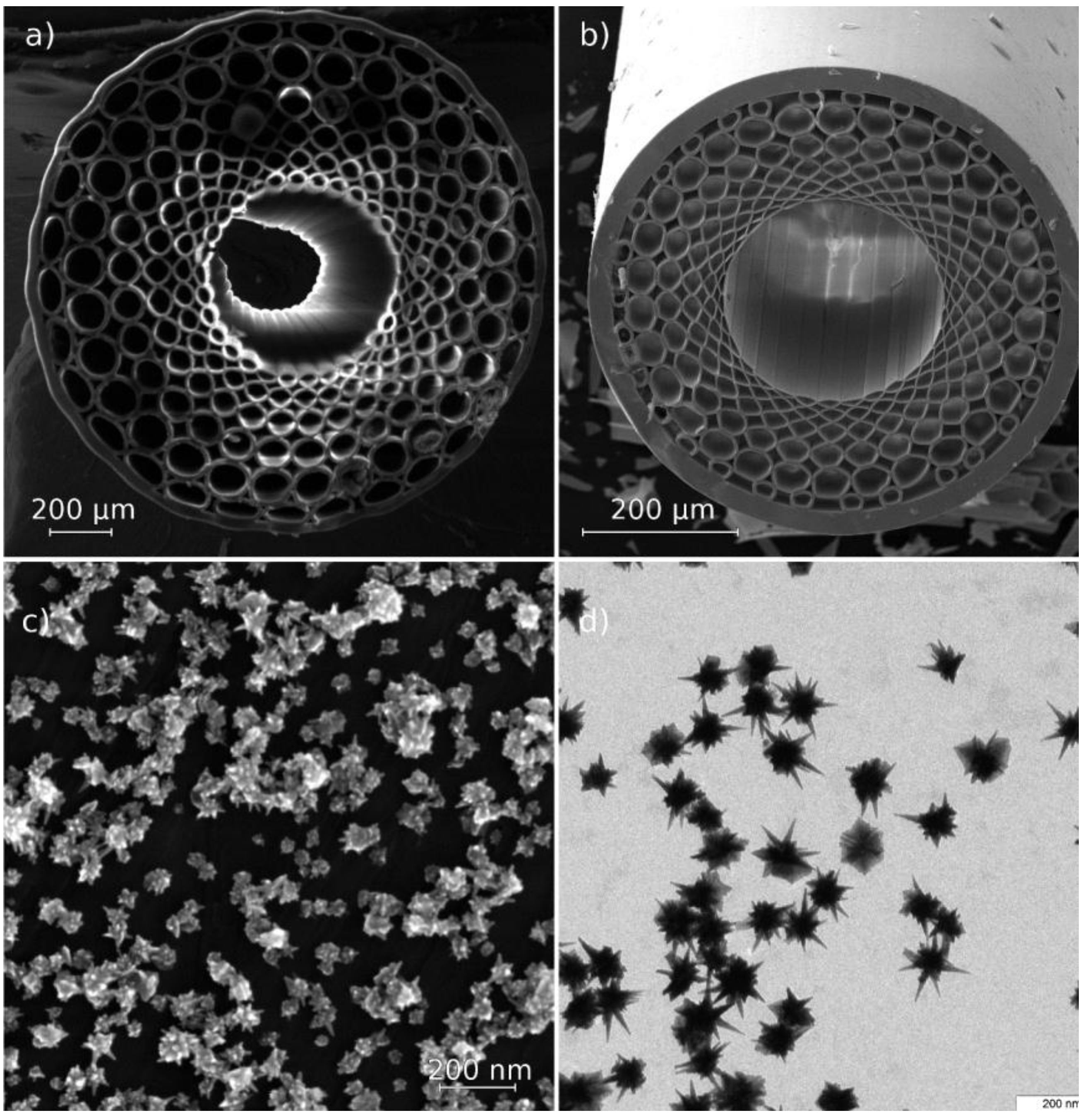
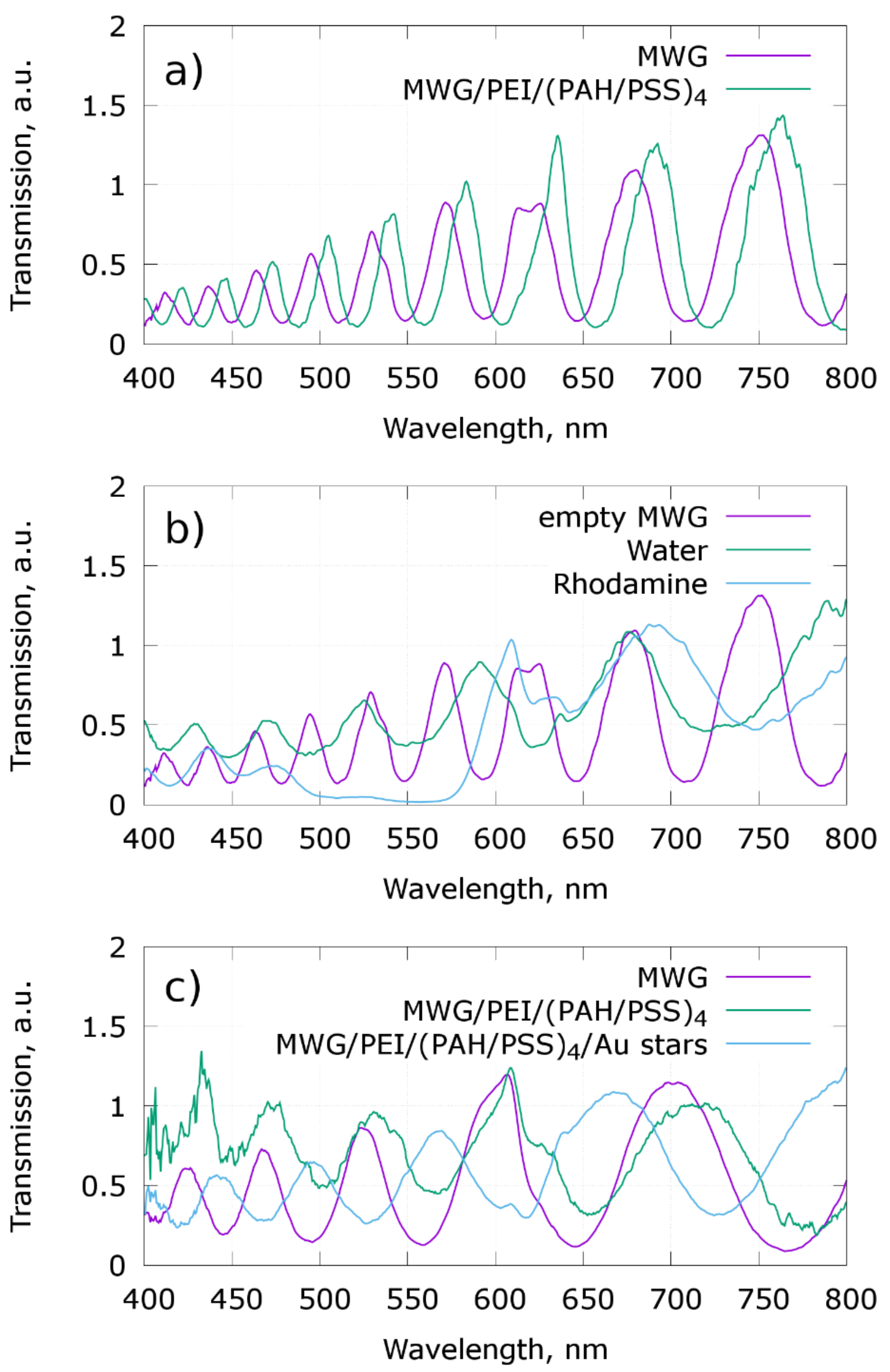
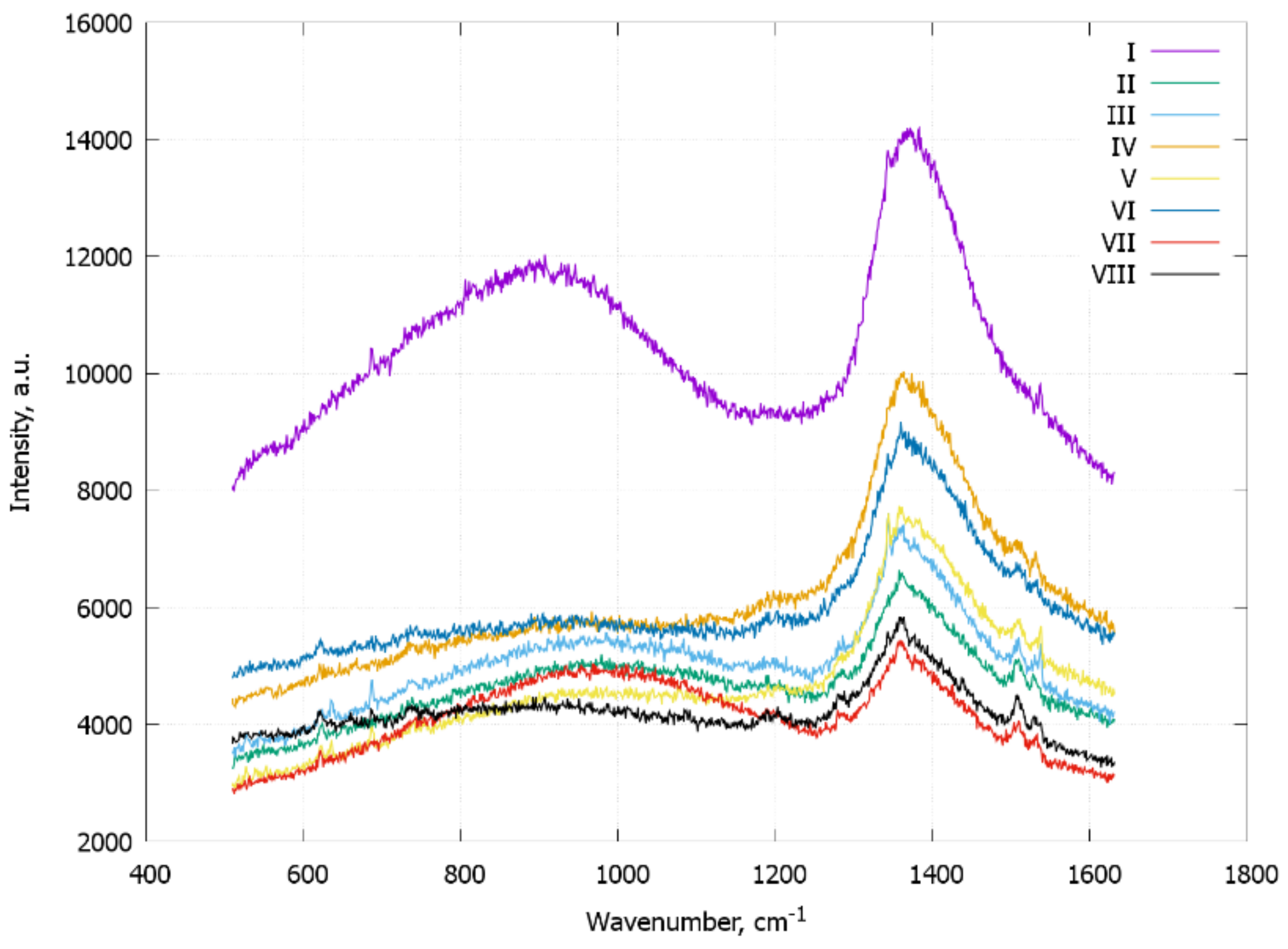
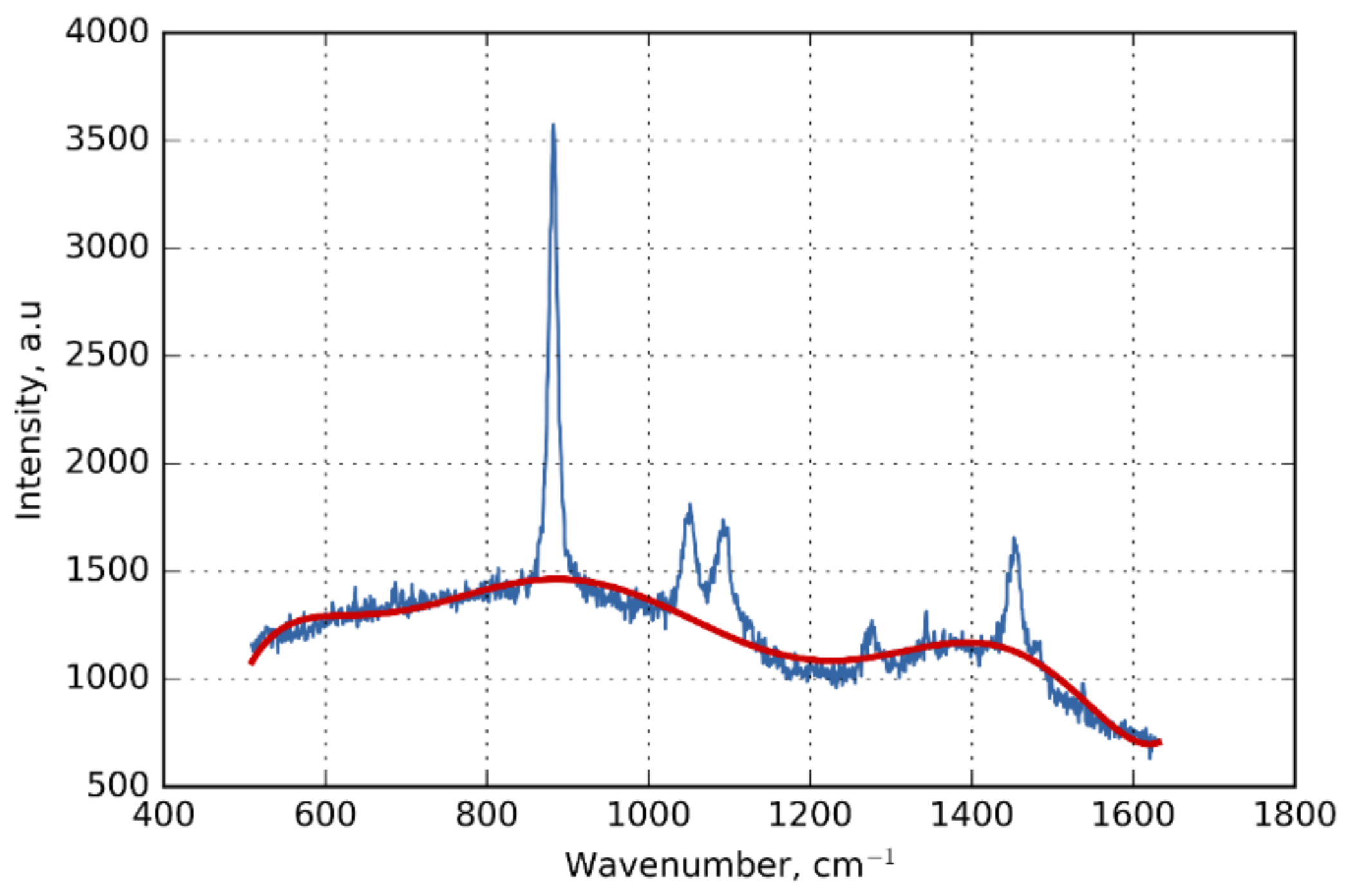
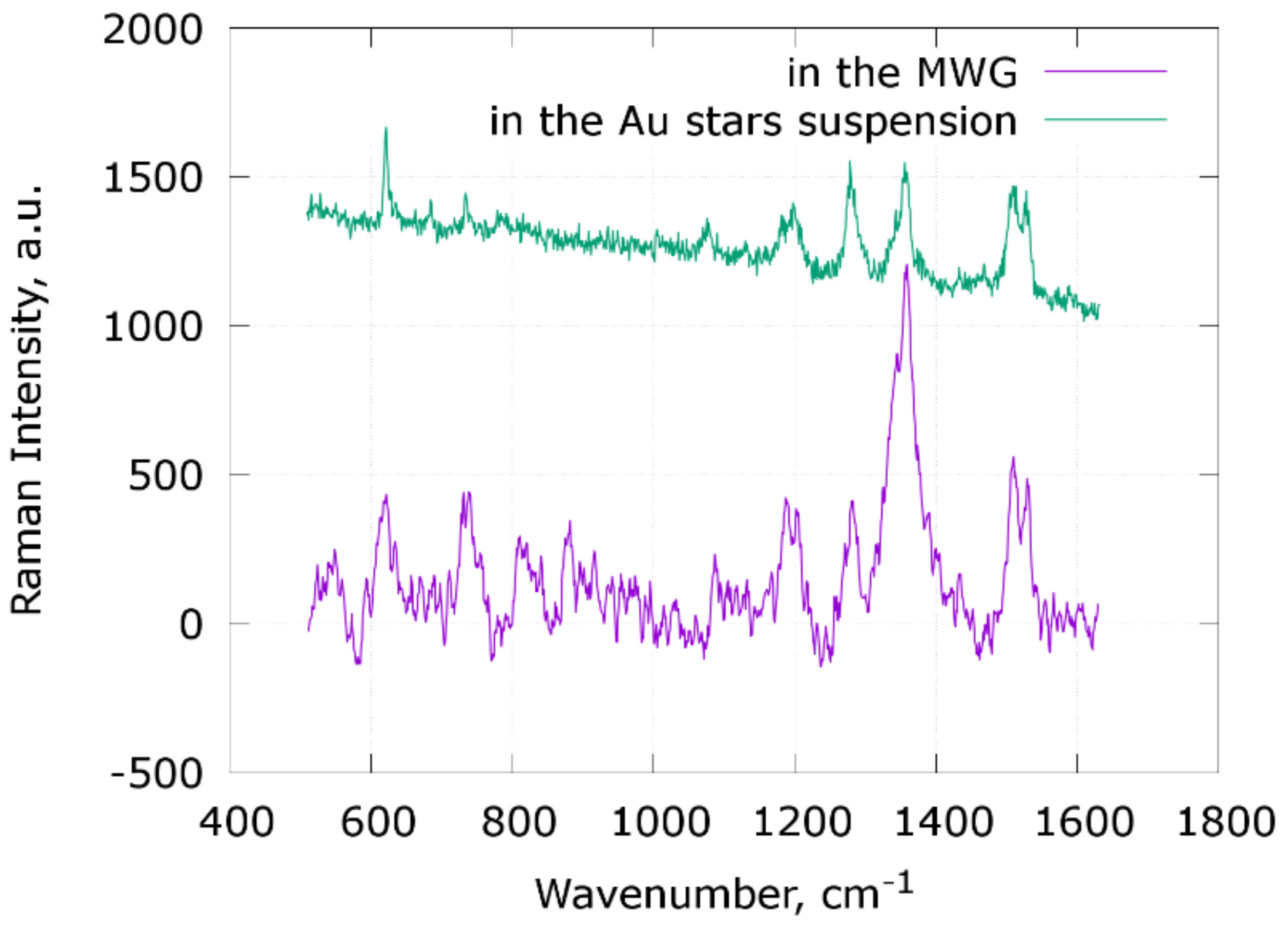
© 2018 by the authors. Licensee MDPI, Basel, Switzerland. This article is an open access article distributed under the terms and conditions of the Creative Commons Attribution (CC BY) license (http://creativecommons.org/licenses/by/4.0/).
Share and Cite
Bratashov, D.N.; Burmistrova, N.A.; Bondarenko, S.D.; Khlebtsov, B.N.; Atkin, V.S.; Shuvalov, A.A.; Zanishevskaya, A.A.; Skibina, Y.S.; Goryacheva, I.Y. Microstructured Waveguides with Polyelectrolyte-Stabilized Gold Nanostars for SERS Sensing of Dissolved Analytes. Materials 2018, 11, 734. https://doi.org/10.3390/ma11050734
Bratashov DN, Burmistrova NA, Bondarenko SD, Khlebtsov BN, Atkin VS, Shuvalov AA, Zanishevskaya AA, Skibina YS, Goryacheva IY. Microstructured Waveguides with Polyelectrolyte-Stabilized Gold Nanostars for SERS Sensing of Dissolved Analytes. Materials. 2018; 11(5):734. https://doi.org/10.3390/ma11050734
Chicago/Turabian StyleBratashov, Daniil N., Natalia A. Burmistrova, Sergey D. Bondarenko, Boris N. Khlebtsov, Vsevolod S. Atkin, Andrey A. Shuvalov, Anastasiya A. Zanishevskaya, Yulia S. Skibina, and Irina Y. Goryacheva. 2018. "Microstructured Waveguides with Polyelectrolyte-Stabilized Gold Nanostars for SERS Sensing of Dissolved Analytes" Materials 11, no. 5: 734. https://doi.org/10.3390/ma11050734
APA StyleBratashov, D. N., Burmistrova, N. A., Bondarenko, S. D., Khlebtsov, B. N., Atkin, V. S., Shuvalov, A. A., Zanishevskaya, A. A., Skibina, Y. S., & Goryacheva, I. Y. (2018). Microstructured Waveguides with Polyelectrolyte-Stabilized Gold Nanostars for SERS Sensing of Dissolved Analytes. Materials, 11(5), 734. https://doi.org/10.3390/ma11050734




